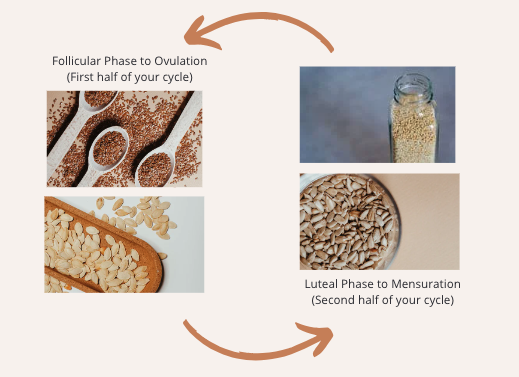
Cycle Syncing and Seed Cycling
A women's body goes through seasons of change with each cycle. The right foods, fitness, and lifestyle strategies can support hormonal shifts, replenish lost nutrients throughout the phases, and detox the body.
What is Cycle Syncing?
One of the many things that makes a woman's body amazing, is that it is constantly changing in respect to our hormones. With each day our hormonal structure is shifting. What is considered balanced one week, looks completely different the next week.
When we respect our natural cycle and adjust our diet, exercise rituals, and lifestyle habits to match with what our bodies need during that part of the month, we see improvements in our energy levels, ability to manage stress, ability to control our weight, and more.
There are four main phases that each women experiences during child bearing ages on repeat throughout the year.
Menstrual phase (typically 3-7 days): During this phase women shed the extra lining of the uterus that has built up in preparation for pregnancy. Blood and fluid are lost and nutrients need to be replenished.
Follicular phase (typically 7-10 days): After your period ends but before ovulation occurs your body begins to rebuild the lining of the uterus in preparation for egg implantation . In addition your body is working to create a mature follicle for a healthy egg to be released.
Ovulatory phase (2 days): During this short phase of approximately 24 - 48 hours, your body releases an egg from the matured follicle. You are producing peak cervical mucus to help guide the sperm towards the egg. To stimulate ovulation, estrogen drops while luteinizing hormone and follicular stimulating hormones peak.
Luteal Phase (typically 10 -14 days): Now it is time for luteinizing hormone and follicular stimulating hormones to get washed away while progesterone is on the rise.
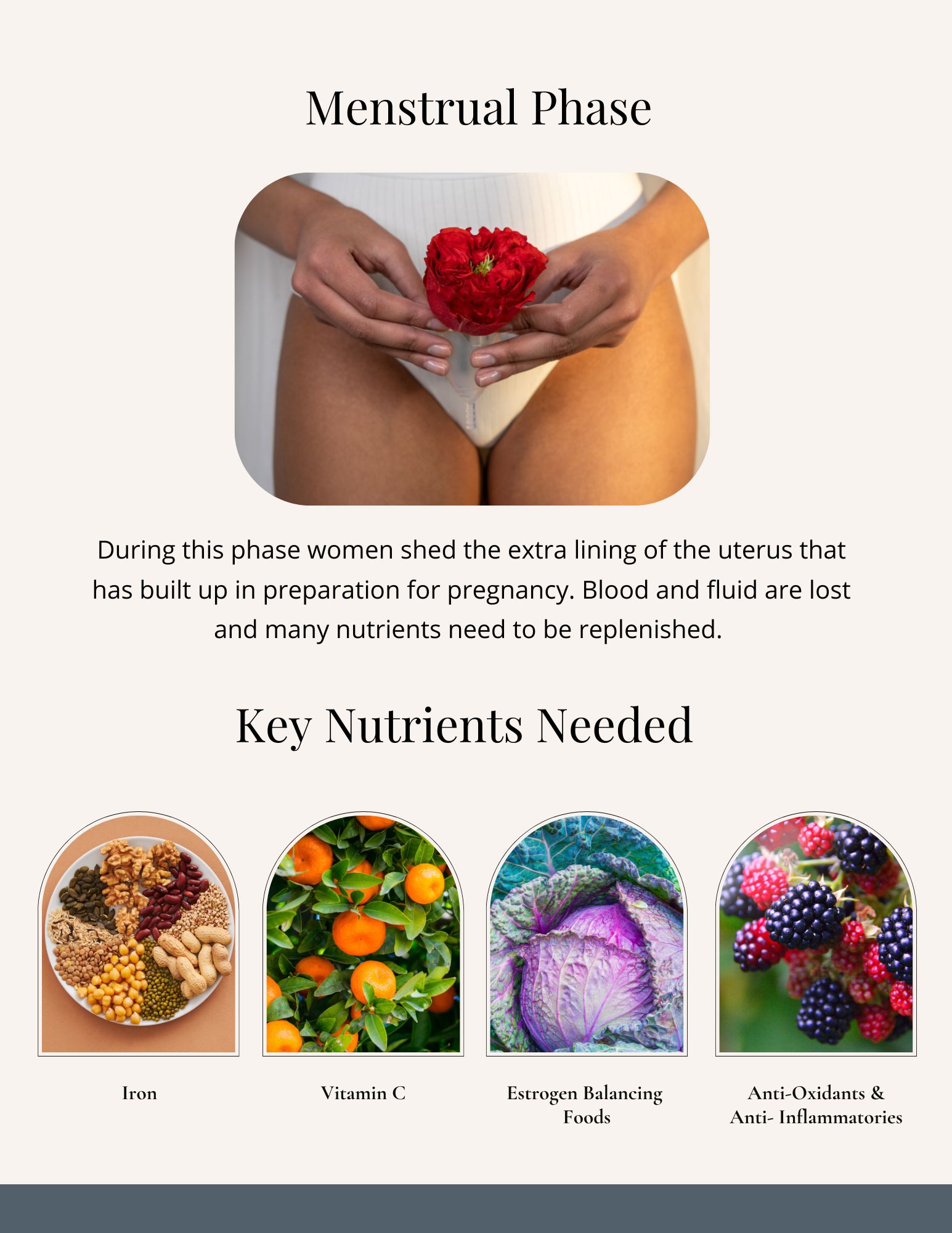
Foods To Incorporate: Menstrual Phase
Iron (eat in combination with vitamin C rich foods):
Spinach, lentils, beans, pumpkin seeds, red meat, shellfish, organ meat, quinoa, turkey, broccoli, fish.
Vitamin C:
Rose hips, guavas, bell peppers, thyme, parsley, spinach, kale, kiwi, broccoli, brussels sprouts, citrus fruit, persimmons, papaya, berries
Estrogen balancing foods:
Flaxseed, coniferous vegetables (broccoli, arugula, brussels sprouts, cabbage, cauliflower, bok choy, collard greens, kale, turnips, watercress).
Anti-oxidant and anti-inflammatory foods:
Berries, dark leafy greens, ginger, turmeric, flaxseed, peppermint tea, green tea
Other:
Fermented foods improve microbiome and reduce risk of yeast infections. Examples are kefir, sauerkraut, kimchi, tempeh, miso.
Other Things to Consider
Eat easy to digest foods:
Eat foods warm and cook vegetables. Protein is important during this phase but try easy to digest protein such as eggs, Greek yogurt, and ground turkey or chicken.
Limit fatty foods:
Avoid fried food and excess oils. Limit saturated fats such as red meat and coconut oil. Avoid processed foods.
Minimize alcohol and caffeine intake:
Caffeine and alcohol can increase menstrual cramps and cause dehydration. Alcohol can increase inflammation and lead to increased fatigue and slow down the healing process.
Fitness:
Your may feel a little slower during this time, honor this. Light resistance training, yoga, and light cardio are suggested during this phase to help moderate energy levels.
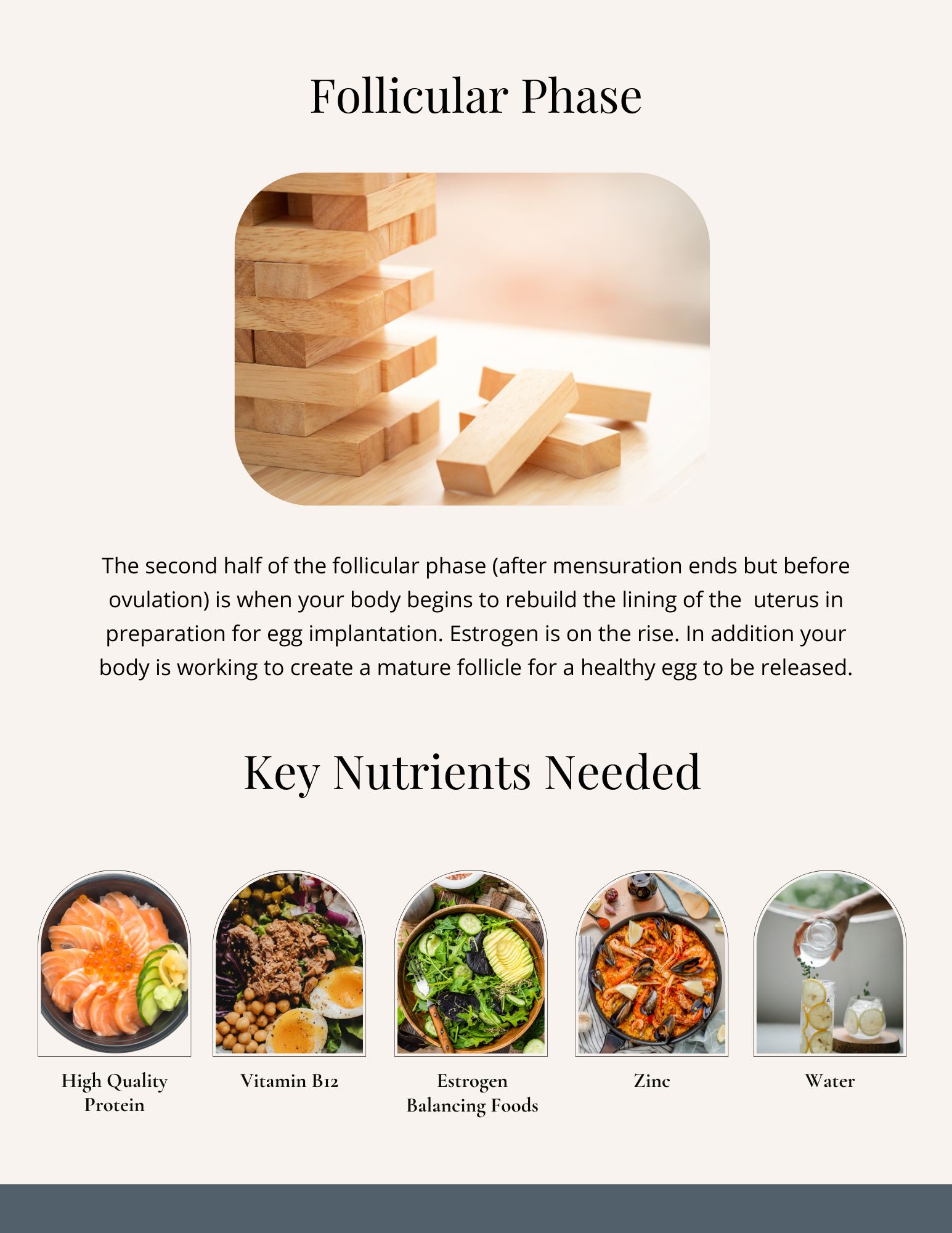
Foods To Incorporate: Follicular Phase
High Quality Protein:
100% grass fed beef, wild caught low mercury fish, pasture raised poultry, pasture raised eggs, nuts (avoid roasted in oil), seeds, lentils, beans, quinoa, spouted grains, Greek yogurt, tempeh.
Vitamin B12:
100% grass fed beef, pasture raised poultry, pasture raised eggs, yogurt, organ meat, clams, sardines, fortified nutritional yeast, trout, salmon.
Estrogen stabilizing foods:
Flaxseed, coniferous vegetables (broccoli, arugula, brussels sprouts, cabbage, cauliflower, bok choy, collard greens, kale, turnips, watercress).
Zinc:
Red meat, shellfish, legumes, hemp seeds, flax seeds, pumpkin seeds, pine nuts, peanuts, cashews, almonds, full fat dairy, pasture raised eggs.
Other Things to Consider
Fitness:
You may feel energy building during this phase and can consider challenging your workouts. Strength training, moderate to high intensity cardio, and even high intensity interval training could be beneficial during this phase.
Get Outside:
Vitamin D3 is an important precursor for hormones and the best way to increase your vitamin D3 is through natural sunlight. If you do work inside or don't have the option to be outside for long, consider taking a supplement.
Carbohydrate intake:
Typically during this phase our bodies are better able to handle blood sugar fluctuations and carbohydrates are well tolerated, especially for the active women.
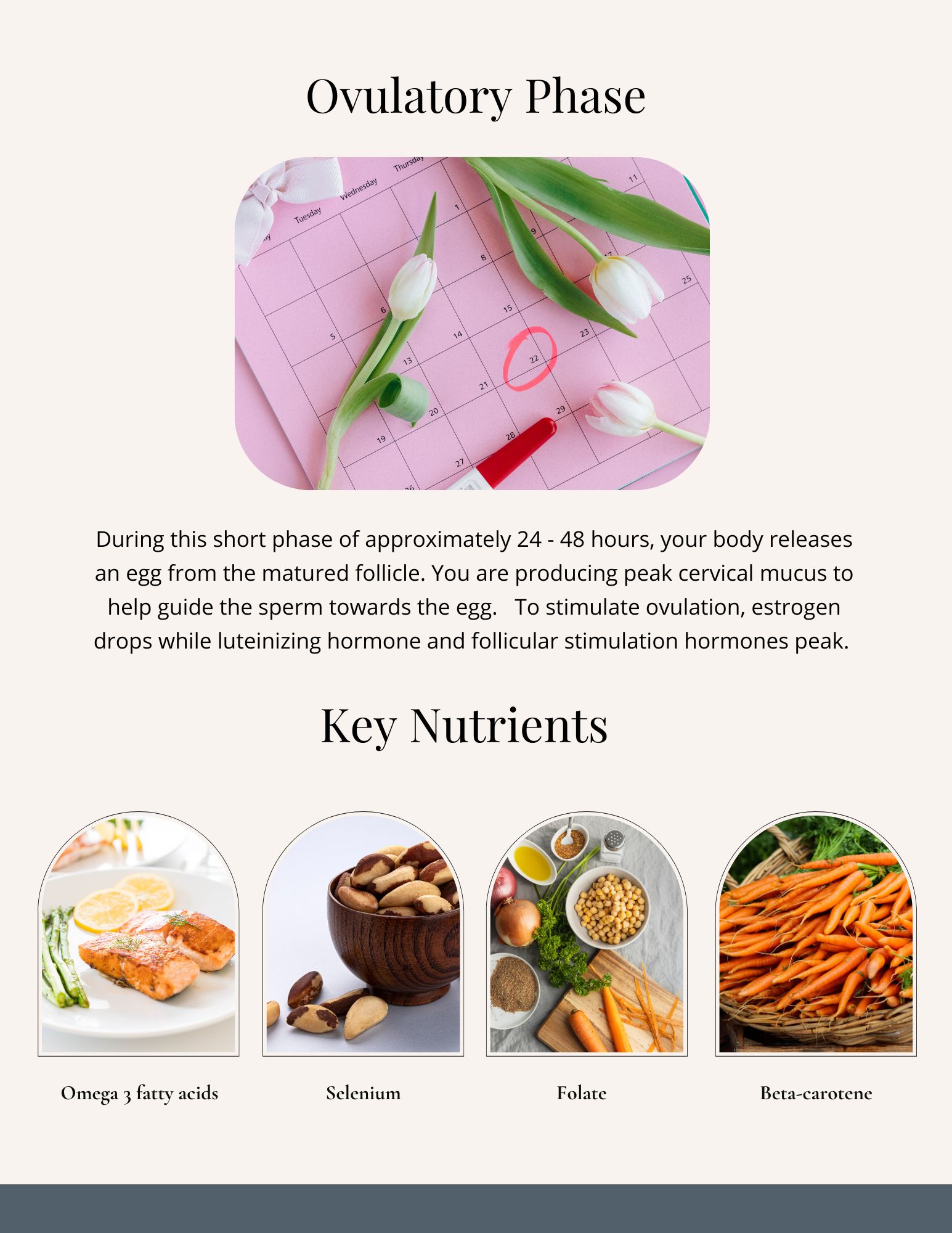
Foods To Incorporate: Ovulatory Phase
Omega 3:
Mackerel, wild caught salmon, sardines, anchovies, herring, chia seeds, flax seeds, walnuts, caviar, omega 3 cod liver supplements.
Selenium:
Brazil nuts, oysters, clams, halibut, sardines, shrimp, salmon, crab, pork, grass fed beef liver, turkey, pasture raised chicken, pasture raised eggs, full fat cottage cheese, sunflower seeds, mushrooms, baked beans, spinach, oatmeal, yogurt.
Folate:
Dark green leafy vegetables, beans, sunflower seeds, peanuts, liver, seafood, pasture raised eggs.
Beta-carotene
Sweet potatoes, carrots, dark leafy greens, butternut squash, red bell pepper, cantaloupe, apricot, broccoli, snap peas.
Other Things to Consider
Fitness:
This is likely the time of your cycle that you will feel the most energized. Strength training, high intensity cardio, and high intensity interval training may be desirable during this phase.
Water:
This might sound obvious but as you become more active staying well hydrated is a must. This will also help you metabolize hormones properly and excrete byproducts easily. One to two times per day you can add lemon juice and pink Himalayan salt to replenish your electrolytes. Water intake during this phase is also very important for cervical mucus production if you are trying to conceive.
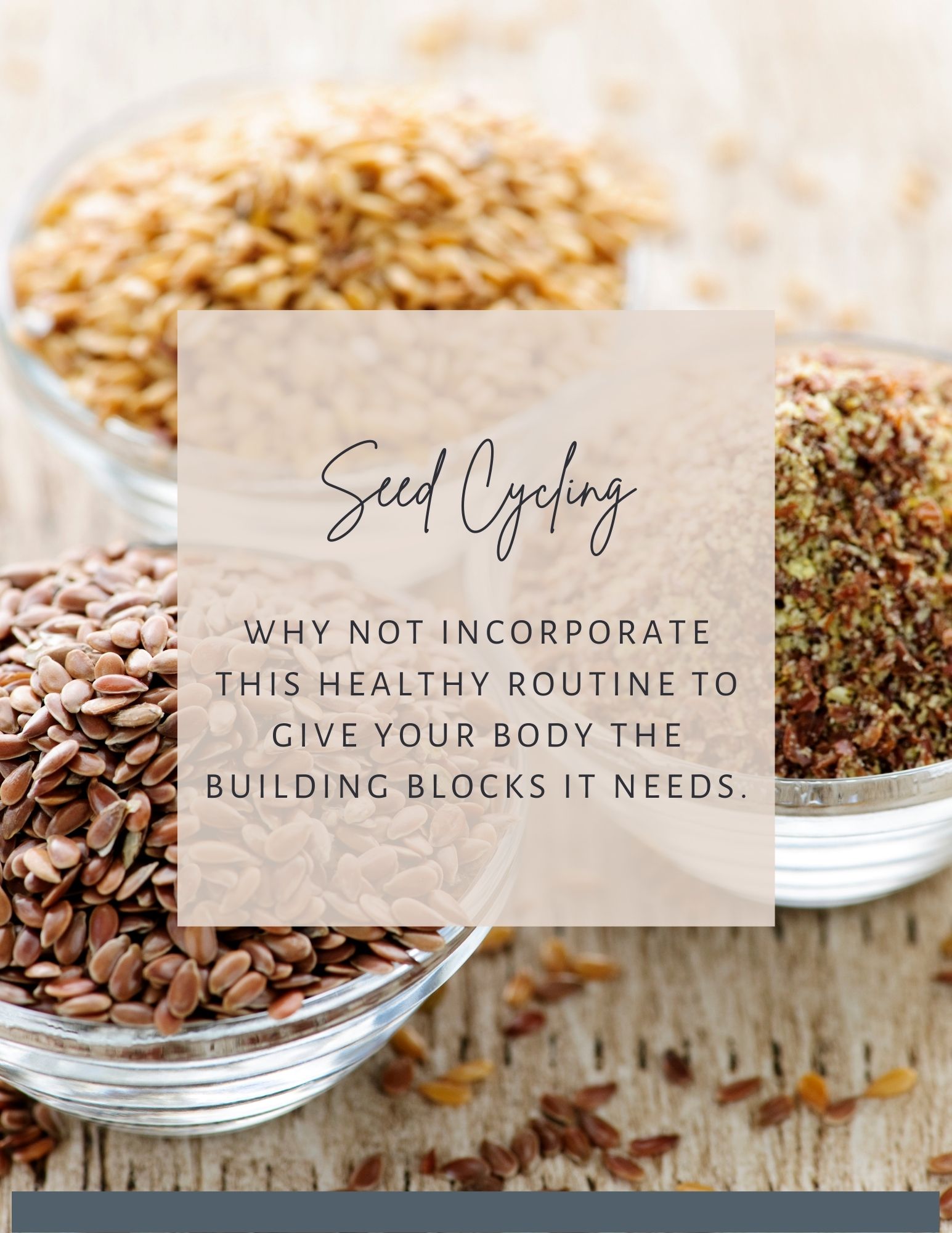
How to do it - Seed Cycling
Follicular phase to ovulation (First day of your period to day of peak cervical mucus): 1-2 tbsp of ground flaxseed and ground pumpkin seed.
Luteal phase to mensuration (following ovulation to the first day of your period): 1-2 tbsp of ground sesame seeds and sunflower seeds
*** If you do not have a cycle to follow, use the moon cycle: Flaxseed and pumpkin seed from the new moon to the full moon. Sesame and sunflower seeds from full moon to new moon. Click here for the lunar calendar.
